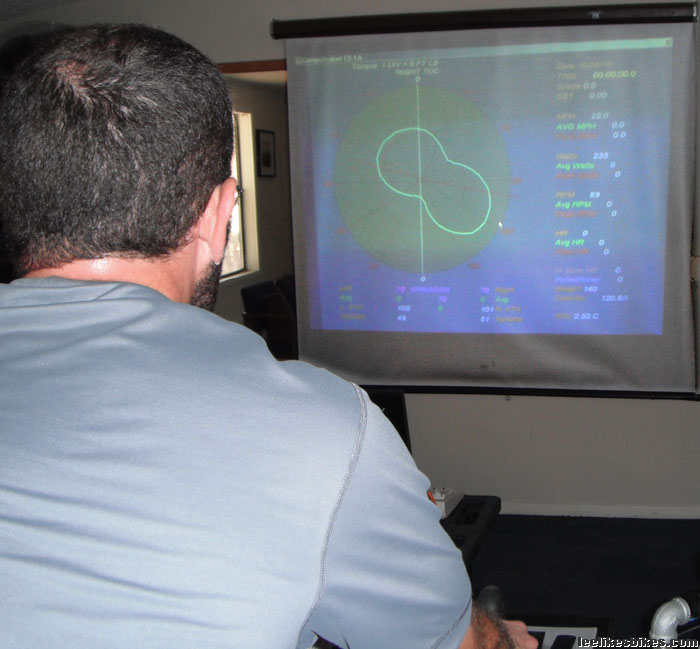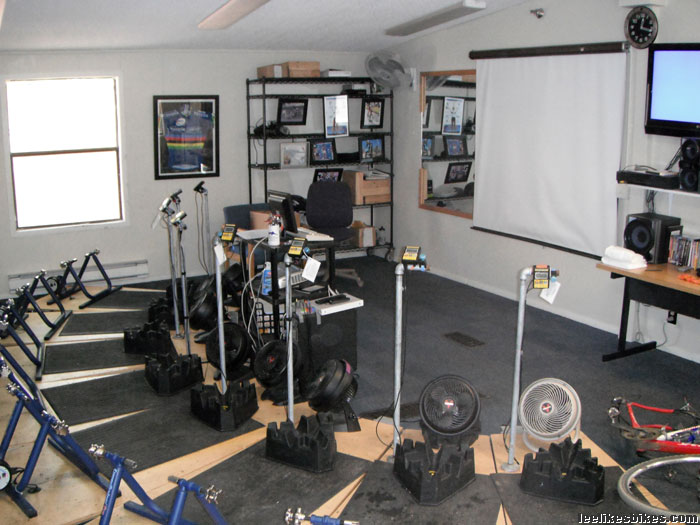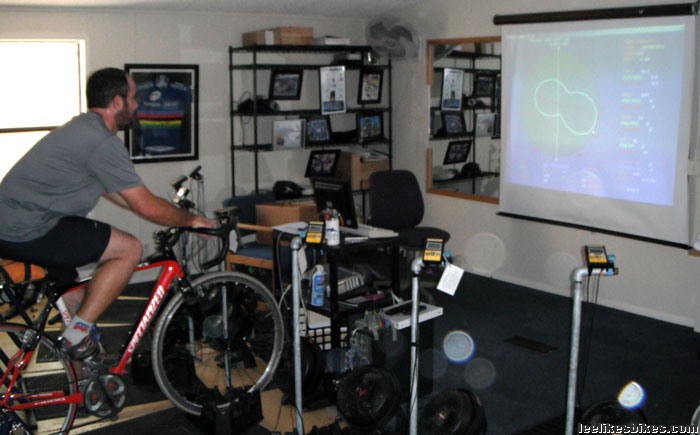CompuTrainer SpinScan radness!

Today I lived one of my nerdy dreams. I went to the Boulder Center for Sports Medicine, hooked my Tricross to a CompuTrainer-equipped trainer and got my pedaling stroke analyzed with SpinScan software.
This experience confirmed some things I was feeling, and it blew one notion out of the water.
Who and where
 The Cave at the Boulder Center for Sports Medicine. |
Lester Pardoe, Boulder Center for Sports Medicine coaching specialist and biomechanical technician, dialed me in at the Center’s “Cave,” which is short for Cave of Pain.
In this small room, eight trainers are tied to the CompuTrainer system. The specialists can do in-depth analysis on a single rider, or they can subject up to eight riders to indoor cycling brutality. I did some of those classes a couple winters ago, and they were awesome. The system sets the resistance for your weight, your power level and the workout protocol. All stats are displayed on a big screen. If I did this class with some of my buddies, an ambulance would be on call.
Sissy excuse: I rode from home to the gym, did a very hard workout, then rode to the Center. My legs were blown when I got there.
How it works
CompuTrainer and SpinScan are powerful programs, and I’m sure I barely scratched their surfaces. To begin, Lester hooked me up and got me spinning. An oblong graph appeared on the screen, signifying the efficiency of my pedal stroke.
A narrow figure eight means terrible stroke mechanics. The rounder the shape, the rounder the stroke.
The screen also showed:
– Current power in watts.
– Current cadence.
– Percentage of power generated by left and right leg. 50/50 is ideal.
– Average Torque Angle (ATA). That’s the average point on the circle where most of your power is applied. A perfect score would be 90 degrees from vertical, or 3 o’clock.
– SpinScan. This number, 0 to 100, signifies the efficiency — the roundness – of your stroke. A score of 100 would mean you’re applying force evenly all the way around the circle, which is impossible. Lester sees SpinScans below 30. The best SpinScan he’s ever recorded was 90, by world champion XC racer Gunn-Rita Dahle (that’s her demonstrating pedaling technique in MMBSii). 75-80 is considered very good.
 Lester said I have good technique and power, but, if I want to sustain that power longer, I need to do more long rides. Can I get a doctor’s note? |
My default
My scores when I just sit, relax and spin.
Power – About 225 watts
Cadence – About 90 rpm
Left/right balance – 50/50
ATA – About 100 degrees, or 3:30
SpinScan – 67
Concentrating on good form
This system is incredible. As you make subtle adjustments to your pedaling style, you can immediately see changes in your stroke shape and power.
Power – I wasn’t paying attention.
Cadence – I was most efficient around 90 rpm.
ATA – When I focused on pushing across the top of the stroke, I could get close to the ideal 90 degrees. But only as long as I focused.
SpinScan – If I focus on pushing across the top of the stroke, I can average about 75. At one point I hit 80, but I have no idea how.
Standing
I love to climb out of the saddle. It just feels good, and I think I have great technique.
When I stood, my SpinScan dropped from 75 to 55. Yikes. When I focused on perfect form … 55. When I tried a really hard gear at low rpm, like when I climb home, 55. Dang.
Lester says you can certainly make more power out of the saddle, but it’s less efficient than sitting.
 Trying to turn that peanut into an egg. |
Things that work
The only way I could consistently improve my SpinScan was to focus on pushing across the top of the stroke. For me, that is the A-1 key. I’ve been working on this all year, and I will continue.
Everything feels (and measures) better at 90-100 rpm. When upshifted and dropped to 60 rpm or lower, my numbers dropped and my already blown legs got heavy and dumb.
Thing that doesn’t work
My lowest SpinScan happened when I focused on pulling up on the upstroke.
At high rpm you can’t pull up; the pedal is moving too fast. I slowed my cadence then focused on pulling up.
I pulled so hard that I could hear my cleats clack in the pedals, and I could feel my feet stretching my shoes’ uppers. And … my SpinScan dropped from 77 to … 45.
I was feeling awkward and working way harder, and my stoke got worse.
Power!
We worked the SpinScan for quite a while, then Lester set me up for some quick power tests. I knew I was beat, but my home trainer maxes at 999 watts, and I was curious.
Peak power: 1,200 watts. This is pretty good but not extraordinary. I want to work on that one.
We also did this rolling-start power test where the rider covers a certain distance as fast as possible. The mens’ record is 20 seconds. I rolled a 23. My peak power was great, then I petered out. I can do better.
Next
I want to do more detailed work on my own stroke, but the research potential is enormous.
Flats vs. clips: Yeah baby, it’s on! Lester said he’s help me test flat vs. clip-in pedals. We’ve all heard the theories and arguments; I want to generate some meaningful data.
Offer this service to my skills clients: I’ve asked how I can get my clients in for this pro treatment. After all, pedaling is a skill, and to pedal better is to ride better.
Power! I want to do a real-deal power test. Like I need more things to obsess over.
Epilogue
After an hour-long gym workout and almost three hours riding at the Center, I rolled the Tricross up Sunshine Canyon to my house. My legs (and whole body) were blown. I just kept it in my 34×28 and focused on pushing across the top of the stroke. Not going fast, not trying to do anything great, just focusing on comfort and efficiency.
And … I reached the top of the climb a full minute faster than ever before. Crazy.
It’s all about pushing across the top of the stroke.
Indoor computerized braaap!
— Lee
Know more. Have more fun!
Join the leelikesbikes mailing list:

Comments are closed.